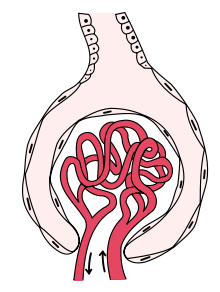User:Whispyhistory/Kidney disease

CKD
Chronic kidney disease stages
| Chronic kidney disease (CKD) staging - CKD G1-5 A1-3 glomerular filtration rate (GFR) and albumin/creatinine ratio (ACR) | ||||||
|---|---|---|---|---|---|---|
| ACR | ||||||
| A1 | A2 | A3 | ||||
| Normal to mildly increased | Moderately increased | Severely increased | ||||
| <30 | 30-300 | >300 | ||||
| G F R | ||||||
| G1 | Normal | 90+ | 1 if kidney damage present | 1 | 2 | |
| G2 | Mildly decreased | 60-89 | 1 if kidney damage present | 1 | 2 | |
| G3a | Mildly to moderately decreased | 45-59 | 1 | 2 | 3 | |
| G3b | Moderately to severely decreased | 30-44 | 2 | 3 | 3 | |
| G4 | Severely decreased | 15-29 | 3 | 4+ | 4+ | |
| G5 | Kidney failure | <15 | 4+ | 4+ | 4+ | |
| Numbers 1 - 4 indicates risk of progression as well as frequency of monitoring (number of times a year). Kidney Disease Improving Global Outcomes - KDIGO 2012 Clinical Practice Guideline for the Evaluation and Management of Chronic Kidney Disease | ||||||
Urine albumin‐to‐creatinine ratio
Urine albumin‐to‐creatinine ratio[1]
Glomerular disease
Glomerular disease is a disorder of the glomerulus in the kidney.[2] It typically presents with blood or protein in urine.[2] Early in the disease there are generally no symptoms and it may be detected on routine urine testing.[2] Complications include high blood pressure and kidney failure.[2]
Causes include diabetes mellitus, auto-immune conditions and infections such as hepatitis B, hepatitis C, HIV and malaria.[2] It is diffuse if all glomeruli are affected and focal if just some.[2] Part of the glomerulus may be involved or the whole unit; segmental and global respectively.[2] The disease may be proliferative, sclerosing or necrotising.[2] Where there is mostly inflammation, it is described as glomerulonephritis, and in the absence of inflammation it is termed glomerulopathy.[3]
Males are affected more than females.[4]
Types
- Glomerulonephritis
- Glomerulopathy
- Glomerulonephrosis
- Endocapillary proliferative glomerulonephritis
- Nephrotic syndrome[5]
- Mesangial proliferative glomerulonephritis
- Membranous nephropathy
- IgA nephropathy
- Paraneoplastic glomerulonephritis
- Henoch–Schönlein purpura
- Fabry disease
- Sickle cell nephropathy
- Focal segmental glomerulosclerosis
Other
References
- ↑ Ren, Fei; Li, Mingzhu; Xu, Hua; Qin, Xiaowei; Teng, Yanling (5 June 2021). "Urine albumin‐to‐creatinine ratio within the normal range and risk of hypertension in the general population: A meta‐analysis". The Journal of Clinical Hypertension. 23 (7): 1284–1290. doi:10.1111/jch.14263. ISSN 1524-6175. PMID 34089300.
- ↑ 2.0 2.1 2.2 2.3 2.4 2.5 2.6 2.7 Rhadhakrishnan, Jai M.; Appel, Gerald B. (2020). "113. Glomerular disorders and nephrotic syndromes". In Goldman, Lee; Schafer, Andrew I. (eds.). Goldman-Cecil Medicine. Vol. 1 (26th ed.). Philadelphia: Elsevier. pp. 753–763535. ISBN 978-0-323-55087-1.
- ↑ Yacoob, M. Magdi; Ashman, Neil (2020). "36. Kidney and urinary tract disease". In Feather, Adam; Randall, David; Waterhouse, Mona (eds.). Kumar and Clark's Clinical Medicine (10th ed.). Elsevier. pp. 1353–1408. ISBN 978-0-7020-7870-5.
- ↑ Beckwith, Hannah; Lightstone, Liz; McAdoo, Steve (March 2022). "Sex and Gender in Glomerular Disease". Seminars in Nephrology. 42 (2): 185–196. doi:10.1016/j.semnephrol.2022.04.008. ISSN 1558-4488. PMID 35718365.
- ↑ "Glomerular Diseases". National Institute of Diabetes and Digestive and Kidney Diseases. Retrieved 28 December 2022.
